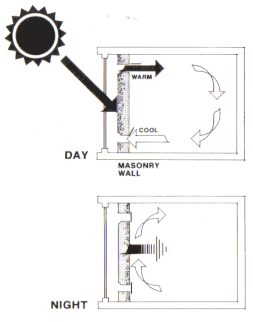Trombe wall

A Trombe wall is a wall with high thermal mass used to store solar energy passively in a solar home. It is named after the French inventor, Felix Trombe, who popularized the design in 1964 although Edward Morse had patented it back in 1881.
A Trombe wall consists of a vertical wall, built of a material such as stone, concrete, or adobe, that is covered on the outside with glazing. Sunlight passing through the glazing generates heat which conducts through the wall. Warm air between the glazing and the Trombe wall surface can also be channeled by natural convection into the building interior or to the outside, depending on the building's heating or cooling needs.
During the day, sunlight shines through the glazing and hits the surface of the thermal mass, warming it by absorption. The air between the glazing and the thermal mass warms (via thermal conduction) and rises, taking heat with it (convection). The warmer air moves through vents at the top of the wall and into the living area while cool air from the living area enters at vents near the bottom of the wall.
At night, a one-way flap on the bottom vent prevents backflow, which could act to cool the living area, and heat stored in the thermal mass radiates into the living area. These vents are an addition to the original Trombe wall design, which relied entirely on conduction through the thermal mass to transport heat to the living area. In the original design, the majority of the heat collected radiates back through the glazing at night or on an overcast day. This problem is best addressed by adding insulation between the collector space and the thermal mass, and arranging for the thermal mass to be heated by the air circulating through the collector space via the one-way flaps. This change avoids the massive loss of heat at night or on overcast days. Modern passive solar design emphasizes the separation of collectors and thermal masses.
